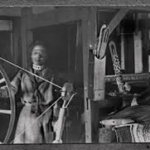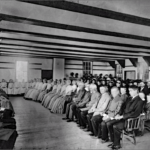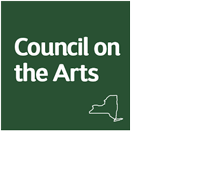Reprinted from the Spring 2020 edition of the Watervliet Shaker Journal.
Written by Lorraine Weiss

In almost all listings of the established Shaker communities, one distinct site is omitted. It was the only urban Shaker community; and it was largely an African American Shaker community. Small in number and often considered an “Out Family” of Watervliet, this was the Shaker Family in Philadelphia that was established through the determination of Rebecca Cox Jackson. It began in late 1858 and continued for almost forty years.
Rebecca Cox Jackson was born in 1795 into a family of free African Americans in Philadelphia. At age 35 she experienced a spiritual conversion during a terrifying thunderstorm. From this point on, Rebecca Jackson’s life was directed by God speaking to her through an inner voice. This spiritual life was not spent in private devotion and participation in church. She was driven far beyond Philadelphia by a desire to preach.
There are a number of parallels between Ann Lee and Rebecca Jackson, who experienced dreams and visions through which she predicted the future. She healed others through prayer, and she practiced what she called her “gift of power” which was manifested in her ability to overcome periods of illness when she felt called to do God’s work. She came to believe that celibacy was the path to a pure life free of sin and she eventually left her husband to follow her new convictions. She later experienced visions that led her to identify a Divine Mother as an aspect of God.
The congregation Ann Lee joined as a young woman had broken off from the Quakers but retained the practice of allowing women to participate and speak during meetings. The African Methodist Episcopal Church did not approve of women leading men in a church service. Rebecca Jackson’s brother, Joseph Cox, was a preacher who held positions with the Bethel African Methodist Episcopal Church, and her activities not only created a rift in the family but also brought her into serious conflict with many church leaders for years. Publicity about the confrontations served to spread the word about her preaching, and this led to an increase of invitations. In some cases, those who tried to prevent her from preaching were won over by her talents.
Like Ann Lee, Rebecca Jackson was an illiterate woman. She was dependent on her brother’s services as correspondent, and had become increasingly frustrated when he would not teach her to read and write. At one point she discovered that he was editing the letters she was dictating. One day, she realized
“[If God] taught the first man to read, he can you. I . . .prayed earnestly to Almighty God that if it was consistent with his holy will, to teach me to read, and when I found I was reading, I was frightened.” (Williams, pp 19-20)
Her new literacy led to a practice of keeping a series of journals that document almost 30 years of her spiritual life. Her writings focus mainly on her religious life, social interactions revolving around worship or preaching, accounts of dreams and visions, and her interpretation of these experiences.
In the early 1830s, after speaking at private prayer groups and becoming involved with a Covenant Meeting of church members, Mother Rebecca embarked on a life as an itinerant preacher. In Called and Chosen, Richard E. Williams notes that she led sixty-nine discussions during the winter of 1836” to Methodist and Baptist congregations and to groups in private homes. While preaching in Albany in 1836, she became involved with The Little Band, a “Perfectionist” group founded during a period of religious revivals. The members decided to observe a Shaker meeting, and Rebecca Jackson was impressed.
When they came in, the power of God came upon me like the waves of the sea. . .For the first time I saw a people sitting and looking like people that had come into a place prepared for the solemn worship of the true and living God, who is a spirit and who will be worshiped in spirit and in truth. This people looked as though they were not of this world, but as if they were living to live forever. (Humez, p. 139)
After continuing her missionary work for six years, she returned with The Little Band and visited the Shakers for several days in January, 1843, during the Era of Manifestations. She spoke with Benjamin Young and Eldress Rebecca Carter, encountered sisters encouraging her to confess her sins, experienced visions in their company, and noted “. . .for the first time in all my life, I have found a people to my sense that I believe to be the true people of God on earth.” (Humez, p. 171)
Despite these strong sentiments, it was not until June, 1847 that Rebecca Jackson and a disciple, Rebecca Perot (also African American) took up residence at Watervliet along with a number of the Little Band members. They witnessed the construction of the new Meeting House in 1848 and its dedication on March 1, 1849. In her essay, “Gifts of Power,” Alice Walker observes:
During her time with the Shakers, Jackson knew much spiritual richness and love. For the first time in her life she felt understood and warmly treasured as one who revealed obvious gifts from God. (Walker, p. 77).
And yet, Jackson was not content. Still guided by an inner voice, she found it hard to submit fully to the Shaker’s authority. Some sources state that she found the Shakers too insular in praying for their own salvation and not that of the world at large. She longed to resume her own mission work. She and Perot returned to Philadelphia and remained for almost six years. In September of 1857, the West Family journal reported the presence of “Rebecca Jackson & little Rebecca, the colored women. They returned last Tuesday to stay. They appear to feel quite humble & thankful for another privilege [opportunity to return].”
After a year, during which Rebecca Jackson finally fully embraced Shaker authority, Eldress Paulina Bates granted permission for her to establish a Philadelphia community, sometimes referred to as an “Out Family.” Jackson recounts that Eldress Paulina stated that she was speaking on behalf of Mother Ann Lee:
Now, Rebecca, you may go to your people and to them all the good you can. Now you can go in the gift of God, and in the gift of the Ministry and the Elders. Now you are endowed with power and authority. Now the Lord hath sent you. You have waited for the Lord, and you go under a blessing. All that you bless, we bless–and whoever sets out to you, and honestly confesses their sins, we own and bless, and receive unto our Society…
(Humez, p. 277)
Likely never numbering more than 20, the members of the Philadelphia family were mostly African American women who worked as domestics, laundresses, or seamstresses. Mother Rebecca’s journals end in 1864 and no records of the community parallel the daily journals kept by the other Shaker Families. However, accounts from Shakers visiting from other communities document the fact that the community remained in union with the Shakers.
For almost 25 years, Mother Rebecca Cox Jackson’s charisma and spiritual powers garnered respect and praise at Watervliet and united a group of followers who lived as Shakers with the World at their front door. She died in 1871 and was buried in Lebanon, Pennsylvania near relatives (not Lebanon, New York). Rebecca Perot assumed the leadership of the Philadelphia family and changed her name to Mother Rebecca Jackson in honor of her friend and mentor. (This leads to some confusion as her photo is often used to represent Rebecca Cox Jackson.)
Eldress Paulina had promised that the Philadelphia members would receive any assistance they needed, and she remained connected with the Philadelphia group for the rest of her life. She and a number of other Watervliet Shakers made extended visits to the group several times a year. In 1872, George Lomas noted “the sincerity and true devotion of that little company. How they had kept the manners and customs of Believers.“ Elder Henry Blinn visited the group on his way to western communities in 1873, documented the layout of the townhouse that served as their residence and worship space, and commented “[t]hey seemed to understand the object of their calling & were resolutely determined to abide faithful.” In 1889, Eldress Harriet Bullard appraised the group: “If any people are clothed with zeal as with a garment, it is this ‘little band.’”
By the 1890s, however, the Philadelphia community had declined. (A study of Philadelphia by W.E.B. DuBois notes a group of Shakers in Philadelphia as late as 1908, but no details are available about the members or the extent of their activity.) In 1896, Mother Rebecca Perot Jackson moved to the Watervliet West Family along with Leah Collins, Harriet Jones, and Alice Sharp. Leah Collins and Rebecca Perot were buried in the Shaker Cemetery. Harriet Jones was one of the last four sisters living at the Church Family when it closed in 1925.
Mother Rebecca Cox Jackson’s story is included in a number of studies of female religious leaders, writers, and African American female mystics and spiritualists. Artists such as choreographer Reggie Wilson also find inspiration in her life and her remarkable writings. After learning of the Philadelphia Shakers’ history, Wilson undertook extensive research and created a new work for his Fist and Heel Performance group. Premiered at Jacobs Pillow in July, 2019, and entitled POWER, the work “re-imagines compelling core Shaker values, contributions, practices and histories. . .”
In the midst of tours, workshops, craft fairs, and other programs, it is important to stop and reflect on those like Mother Rebecca, who found their destiny within the Shaker community and whose voices once resonated within the walls of the 1848 Meeting House. It is intriguing to think that she is still reaching people in one way or another.









